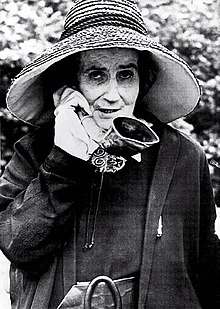Elisabeth de Meuron
Louise Elisabeth de Meuron-von Tscharner , pronunciation : [ ˈd̥œmœˌrɔ̃ː ], better known as Madame de Meuron (born August 22, 1882 in Bern , † May 22, 1980 in Riggisberg ), was a personality from the Bern patriciate .
Life
Elisabeth de Meuron b. von Tscharner was born in the family's town house on Münsterplatz - today the seat of the cantonal finance department - as the daughter of Ludwig von Tscharner and Anna (née von Wattenwyl ). Her father was a doctor of law and a colonel in the engineering troops . Elisabeth was released into a bourgeois dominated life completely unprepared by her parents. Although artistically gifted, her father refused to attend the arts and crafts school. A love marriage with a man from Zurich was prevented by her parents for reasons of class, and she had to marry her (homosexual) cousin Frédéric-Alphonse de Meuron in 1905 . The marriage ended in divorce in 1923, but she kept the family name of her ex-husband. Her son Roger committed during a festive reception at Castle Rümligen 1939 in the basement of suicide , her daughter Louise escaped from the psychiatric clinic in French-speaking Switzerland to Tangier in Morocco . The fate of her son caused Elisabeth de Meuron to wear mourning clothes all her life. She studied philosophy in detail and wrote countless letters.
De Meuron's manorial lifestyle was striking. She was the owner of several houses in the old town of Bern and the Alp Rämisgummen above Eggiwil . In addition, she inherited Amsoldingen Castle on her father's side and Rümligen Castle on her mother's side , her main residence for many years. In Rümligen she regularly organized the famous Concours hippique (show jumping) in the presence of political and military celebrities. She died at the age of almost 98 in the Riggisberg District Hospital. Her grave is in the Gerzensee cemetery .
Parts of Elisabeth de Meuron's estate were auctioned in November 1981 by the Galerie Jürg Stuker AG in Bern.
Anecdotes
The conspicuous and sometimes provocative way of life of the increasingly lonely Elisabeth de Meuron led to countless anecdotes. To her role as the Bern City stock contributed not only their anachronistic appearance with old-fashioned mourning clothes , walking stick and stethoscope - So Ghor i nume what i wott! (“So I just have to listen to what I want to hear!”) - with, but also her eccentric behavior. She was often out and about in the city with her Russian greyhounds . Your servant was allowed to leave the car anywhere; she explained to the policeman who was present: Me laht there! ("You leave that here!"). She always used the Bern tram without a ticket , because: I bi before em Tram da gsi (“I was there before the tram”). She asked strangers directly: Syt dihr öpper or namet dihr wages? ("Are you someone or do you receive wages?"). When a farmer wanted to sit on the Frisching family's pew in the Thurnen church, she instructed him: In heaven obe sy mer mynetwäge alli glych, but now and then we mer einschtwyle no Ornig ha! ("In heaven above we will all be considered the same for my sake, but down here we want to keep order for the time being!"). And when they on their Schlossgut a vagabond (in her words: schturms Froueli, Tschaaggeli "a confused little beggar") () caught at a fruit theft, she locked it for two days in the coach house . Because of false imprisonment accused, she showed in court a medieval certificate of lower jurisdiction for the Rümliger castle owners; she was released with a briefing on the current legal system and a small fine.
literature
- Karoline Arn: Elisabeth de Meuron-von Tscharner. The lioness's desire to fly. Bern 2014.
- Karoline Arn: «I was born a whirlwind». In: Der Bund , January 12, 2014, accessed on May 13, 2018.
- Karoline Arn: «You have to be conscientious in pretending to be in life» . In: Der Bund, January 18, 2014, accessed on January 20, 2014.
- Rosmarie Borle et al .: Madame de Meuron August 22, 1882 - May 22, 1980. A souvenir album. Erpf, Bern 1980, ISBN 3-256-00019-3 .
- Anne-Marie Dubler : Meuron, Elisabeth de. In: Historical Lexicon of Switzerland .
- Big auctions November 12th to November 28th 1981 and December 3rd to 5th , Galerie Jürg Stuker AG Bern, 1981.
- Hans A. Jenny: Swiss originals. Portraits of Swiss individuals (= volume 1). Nebelspalter, Rorschach 1991, ISBN 3-85819-158-2 , pp. 76-79.
- Susy Langhans-Maync: Madame de ... Viktoria, Ostermundigen 1971; 11 A. 1984, ISBN 3-85958-007-8 . (in Bern German ).
- Guy de Meuron: Histoire d'une famille neuchâteloise. Attinger, Hauterive 1991, ISBN 2-88256-050-8 .
- Michael Stettler: Go ahead. Figures and examples. Stämpfli, Bern 1981, ISBN 3-7272-0049-9 .
Web links
Individual evidence
- ↑ Stuker 1981, pp. 6-9.
- ^ Daniel spokesman: Missed opportunity. Review in: Neue Zürcher Zeitung of December 2, 2014, accessed on May 13, 2018.
| personal data | |
|---|---|
| SURNAME | Meuron, Elisabeth de |
| ALTERNATIVE NAMES | Meuron, Louise Elisabeth de |
| BRIEF DESCRIPTION | Swiss aristocrat, Bernese original |
| DATE OF BIRTH | August 22, 1882 |
| PLACE OF BIRTH | Bern |
| DATE OF DEATH | May 22, 1980 |
| Place of death | Riggisberg |




